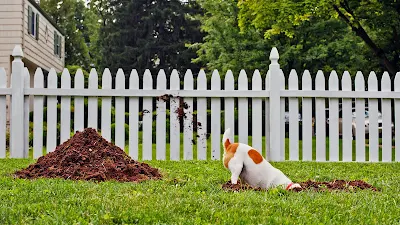How to Manage a Yard with a Dog
Dogs are man’s best friend, but the same cannot be said for man’s lawn. Dogs can ruin hours or days of lawn labor with an afternoon of playtime. Dogs love to dig up dirt, pull up grass, and answer nature’s call wherever it pleases them. While messing up your yard doesn’t harm your dog, it can hurt your lawn. These lawn tips will help you keep Fido and your yard on good terms.
It's easy to forget your four-legged friend in your pursuit of a beautiful lawn. See our pet-friendly lawn care advice!
Dogs love to dig, whether it’s in the dirt, in the grass, or in your flower garden. A dog’s digging behavior is only natural. However, this behavior can damage your yard and cost you precious money and time. It’s important to constantly train your dog not to dig up your yard… however, the best training methods will always follow a “no” with a “yes.” If your dog is not allowed to dig up your regular lawn, provide an area that is “dog friendly” where your pet can dig to their heart’s desire instead of attempting to suppress their natural instinct to dig.
Digging up dirt, plants and grass
Looking for a pet-friendly artificial grass? We have all the information you need to get started with pet turf.
Eating plants
Dogs may eat plants to quell stomach sickness or out of curiously. Aside from the annoyance at a ruined plant due to Fido’s chompers, some plants are actually very dangerous to dogs and can cause them to get sick or even be fatal. It’s vital to research any plants or flowers you use in your yard as well as any existing plants or flowers and make sure they are not poisonous should your dog (or other pet!) decide to consume them.Why do dogs eat grass? Is it safe or dangerous? When do you need to be worried? Learn the reasons why dogs eat grass.
Dog spots
Although the most immediately visible mess dogs can make in a yard are dug up plants, it’s actually a dog’s urine which leaves permanent damage in your yard. How? With dog spots. “Dog spots” are areas of yellow or brown discoloration on grass, tree trunks and other plants caused by a chemical in dog urine. These spots can be unsightly and cannot be removed, so any plant life stained with a “dog spot” needs to be replaced. In short, dog spots can be costly!Is dog urine destroying your lawn? Learn why dog urine stains grass brown or yellow and how to stop it from happening in your yard.
There are several ways to deal with dog spots in your yard.
You can replace most or all of your grass lawn with areas of hardscape. Hardscapes are hard materials like stone, masonry, marble, or other hard materials. These materials do not stain like grass if a dog decides to do his business on them. However, hardscape can cost money to install and may not even compliant with your local area’s homeowner rules.You can replace your grass lawn with a grass alternative that does not stain because of dog urine. Clover lawns, made of clovers (which do not stain because of dog urine!) are becoming increasingly popular due to their easier maintenance.
You can attempt to dilute the dog urine by spraying the areas affected immediately with water. While this tactic may work, it isn’t very practical unless you always want to carry a hose if you walk your dog and you keep an eye on the yard to make sure no wandering dogs relieve themselves in your lawn. However, in an emergency, it is a useful way to prevent an accidental dog spot.
You can “compromise” with your dog’s natural behavior by recognizing their need to mark territory while protecting the grass areas of your lawn. A common way of achieving this is to install a fence around the perimeter of your yard, this will make it a prime spot for your dog to mark its territory. However, install hardscape (such as stone) in the area before the fence. Your dog will likely relieve itself along the fence line, however, its urine will not leave stains. You can also install hardscape in areas where your dog already relieves themselves, making it more likely that they will urinate on stone or other hardscape and not your grass.
You can try to train your dog not to relieve itself on grassy areas of your yard. This can be achieved by promoting the use of a non-grassy area, such as on gravel or dirt, over the grass covered areas of the lawn. Some dogs may respond well to this type of training, while others may give you more trouble or not respond at all.
This tactic will take lots of training and consistency.
Your dog and your lawn do not have to be sworn enemies. There are many methods of controlling dog spots and making sure that you and your pet get the most out of the yard.
German Shepherds are well recognized as police dogs, but they also make wonderful family pets. This is how to train a German Shepherd puppy.



